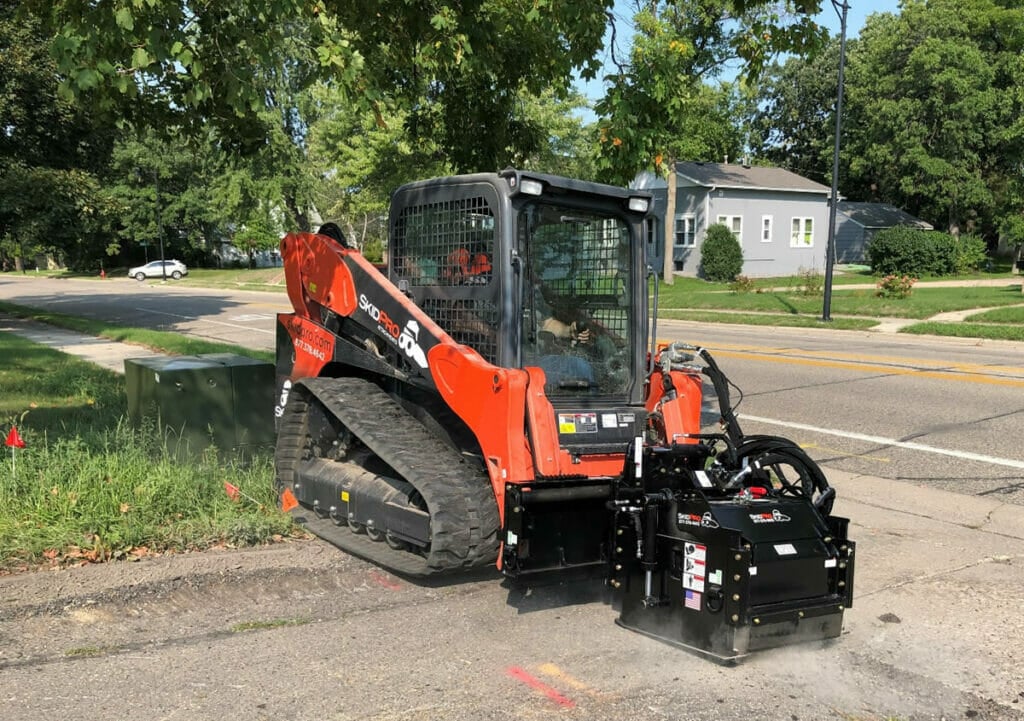
Whether you’re a contractor, farmer, landscaper, or municipality, your skid steer is only as productive as the attachments you run. But here’s the catch: not all attachments are plug-and-play. If your hydraulic flow doesn’t match the tool, you’re wasting time, fuel, and money.
This guide explains everything you need to know about skid steer hydraulic flow—what it is, why it matters, how it affects attachment performance, and how Skid Pro helps you get the right match every time.
What Is Hydraulic Flow on a Skid Steer?
Hydraulic flow is the volume of hydraulic fluid your skid steer delivers through its auxiliary hydraulic circuit—measured in gallons per minute (GPM). This flow powers attachments like brush cutters, trenchers, augers, snow blowers, mulchers, and more.
Think of hydraulic flow as the fuel supply for your attachment. Not enough, and your tools will underperform. Too much, and you could damage your equipment.
Hydraulic Flow vs. Hydraulic Pressure: Know the Difference
Understanding flow vs. pressure is crucial:
Hydraulic Flow (GPM) – Determines how fast the fluid moves. Affects the speed of your attachment (e.g., how fast a mower blade spins).
Hydraulic Pressure (PSI) – Measures force. Affects the power behind the motion (e.g., how forcefully a stump grinder cuts).
What You Need:
You need both flow and pressure in balance. Flow gets the attachment moving. Pressure gives it muscle.
Types of Hydraulic Flow Systems
There are two primary categories of hydraulic systems in skid steers:
1. Standard-Flow Hydraulics (12–25 GPM)
- Common in most skid steers.
- Suitable for general-purpose attachments:
2. High-Flow Hydraulics (26–45+ GPM)
- Found in more advanced or heavy-duty skid steers.
- Required for high-demand attachments like:
Note from Skid Pro: Some machines offer an “enhanced high-flow” package that not only increases GPM but also boosts PSI. That extra pressure can make a big difference in torque-heavy tools.
Why Hydraulic Flow Matters (More Than You Think)
Here’s why matching flow matters:
1. Performance: If your flow is too low, the attachment will run slow, inefficient, or not at all. You’ll burn fuel and time without getting the job done.
2. Equipment Protection: Too much flow? You could overheat the tool, damage seals, or destroy motors. That means costly downtime and repairs.
3. Warranty Risk: Many attachment manufacturers—including Skid Pro—void warranties if the attachment is used outside its rated GPM range.
4. Return on Investment: Attachments aren’t cheap. Matching flow ensures you’re getting every dollar of performance from your investment.
How to Check Your Skid Steer’s Hydraulic Flow
Before buying an attachment, confirm your machine’s flow rating using one of these methods:
- Operator’s Manual – Look under the hydraulic specifications section.
- Model Plate/Decal – Some skid steers list flow on a side panel or inside the cab.
- Manufacturer Website – Input your machine’s model for full specs.
- Call Skid Pro – We’ll tell you exactly what flow your unit has and what tools match.
Pro Tips to Maximize Hydraulic Efficiency
Want to get the most out of your attachments? Follow these maintenance and usage best practices:
- Warm up your hydraulic system in cold weather before use.
- Change hydraulic filters on schedule to avoid restriction and contamination.
- Monitor fluid levels weekly.
- Inspect couplers and hoses for leaks or pressure loss.
- Don’t use restrictors or adapters unless professionally advised.
Why Choose Skid Pro for Hydraulic Attachments?
Skid Pro isn’t just an attachment supplier—we’re a performance partner.
Here’s how we help you get the hydraulic match right:
Real-Time Flow Matching: Tell us your skid steer model, and we’ll tell you exactly what your hydraulic flow is—and which of our attachments are built to work with it.
Custom Configurations: Need a brush cutter tuned for 32 GPM instead of 28? We’ll make it happen.
U.S.-Built Equipment: Every Skid Pro attachment is made right here in America, with better flow-tested hydraulics and industrial-grade components.
Lifetime Tech Support: We don’t disappear after the sale. If your tool isn’t running how it should, we’ll help you troubleshoot—fast.
Let Skid Pro Take the Guesswork Out of Hydraulics
Choosing attachments should be simple—not risky. Let the experts at Skid Pro match your machine and task to the right flow-rated tool.
Call now: 877-378-4642
Visit: https://skidpro.com/
Get a free spec match: contact Skid Pro Gurus
Don’t waste money on mismatched attachments. Get it right with Skid Pro.
FAQs:
Q: What is hydraulic flow on a skid steer?
A: Hydraulic flow is the amount of hydraulic fluid your machine delivers to attachments, measured in gallons per minute (GPM). It powers tools like augers, brush cutters, and snow blowers.
Q: How do I check my skid steer’s hydraulic flow?
A: You can find the GPM rating in the operator’s manual, machine spec sheet, or by contacting the manufacturer. Skid Pro will also verify it for you.
Q: What happens if hydraulic flow is too low for an attachment?
A: The attachment may underperform, run slowly, or fail to operate entirely. Long-term use below required flow can cause damage.
Q: Can I use a high-flow attachment on a standard-flow machine?
A: No. Doing so risks underpowering the tool and damaging internal components. Always match flow requirements.
